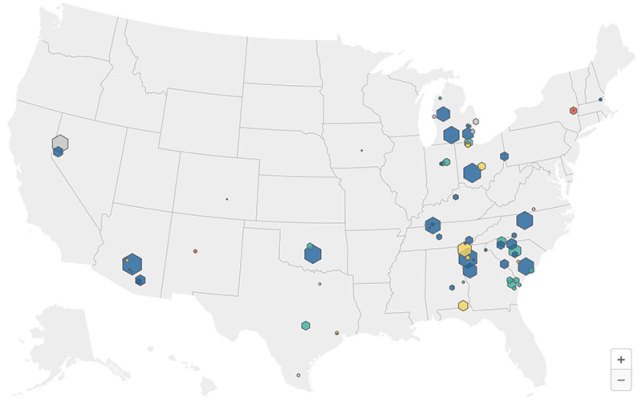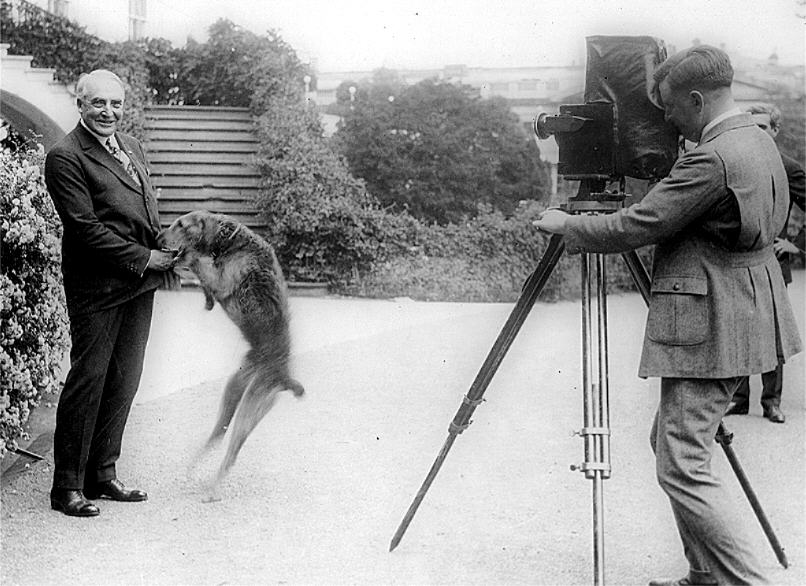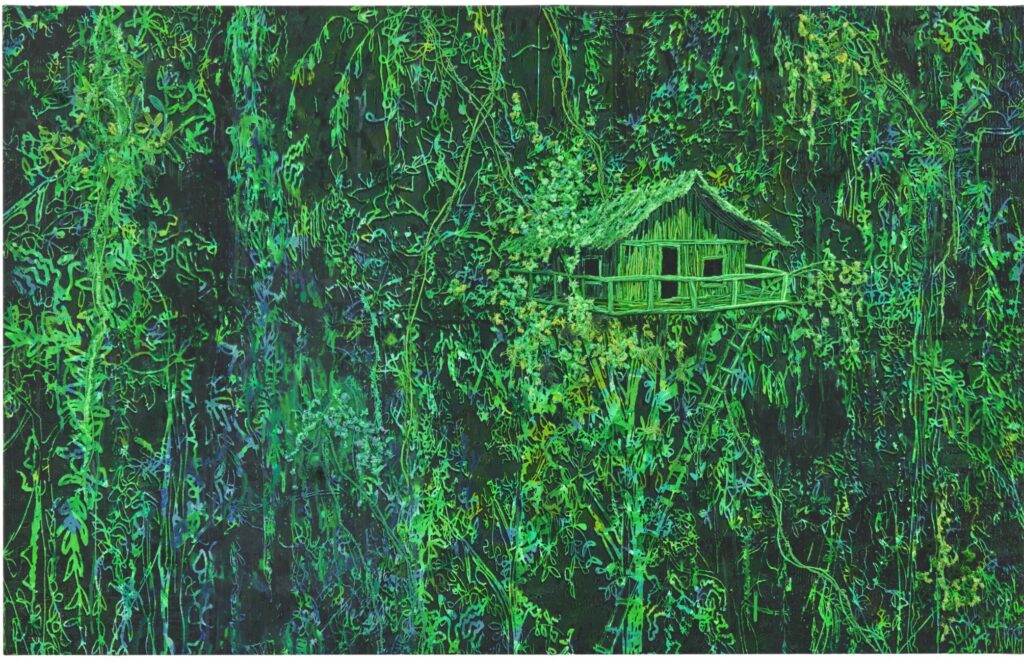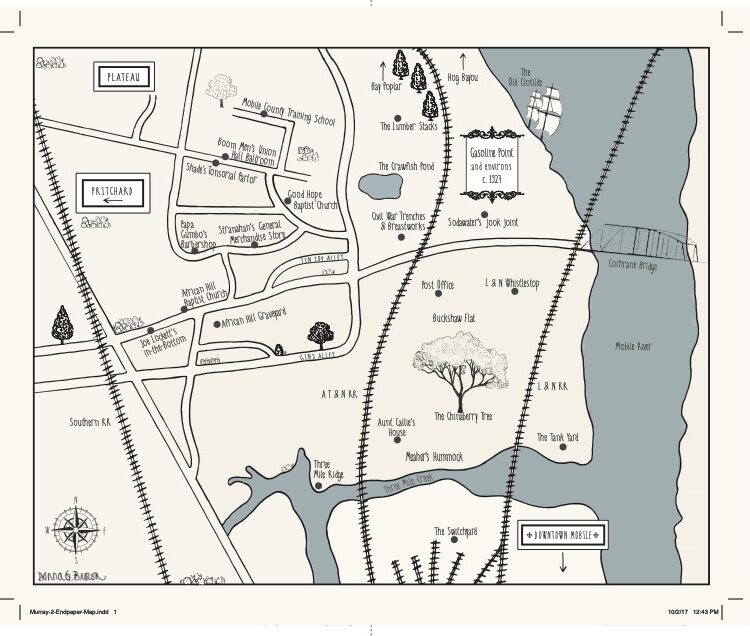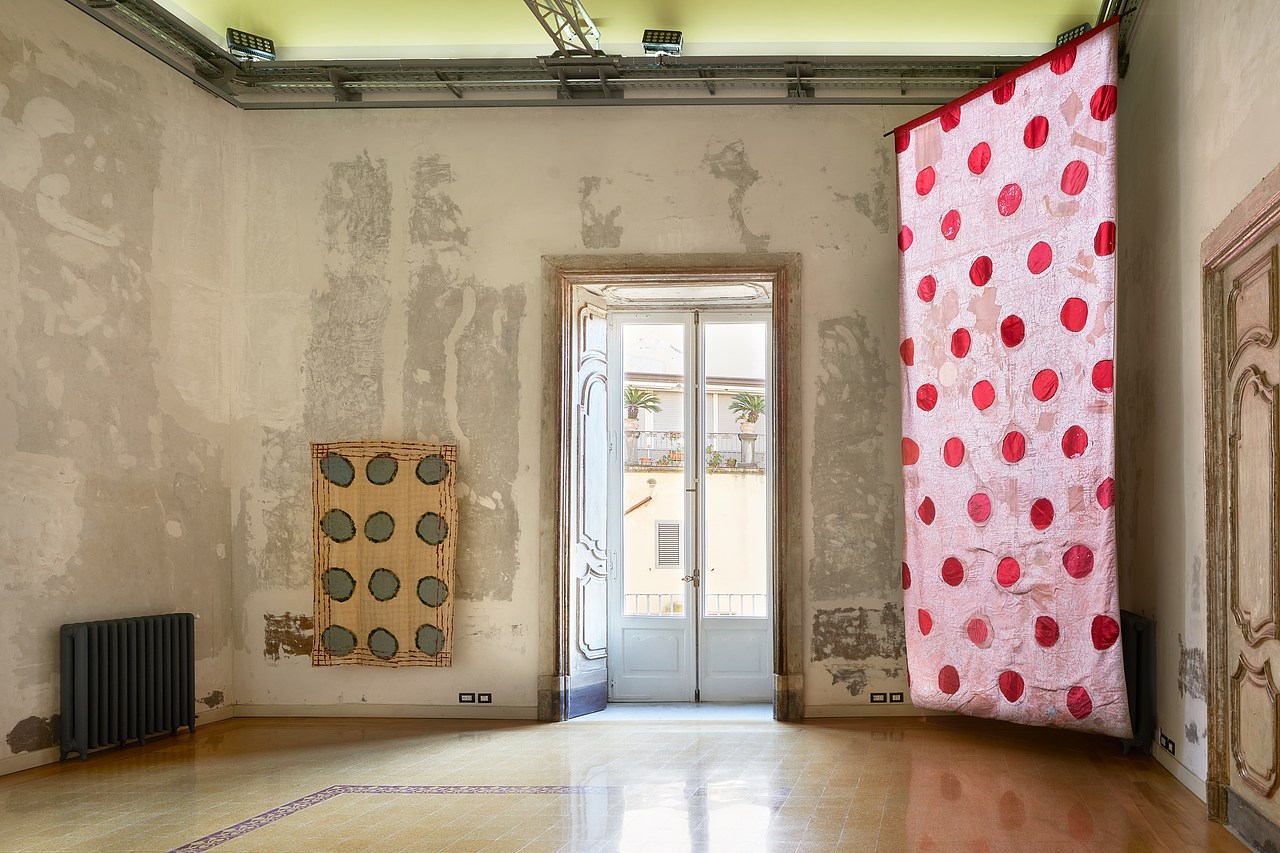Michael Raedecker, solo 2021. Courtesy of the artist.
In a novel that she had been trying to read the night before, she’d read the description of a late spring day as a glittery day, and she thought of that as she was walking with her daughters, and the dog, up through the boulevards. It was turning from a warm into a hot day, even though it was still morning, and not yet summer. The dog was panting, and they took a break, to drink their bottles of water thrown underneath the stroller. There was something filmy to the skin of her daughters, she had dressed them that day in their lightest clothes, and later, she had promised, they could put on their swimwear at the local splash pad. Before leaving she had quickly pulled their hair off their faces, and now they kept on taking off their hats and handing them to her, and she would throw them in the bottom of the stroller. They needed to get their hair washed tonight, she observed, as she looked at them, their curls greasy with sunscreen. The children had decided they wished to dress alike, or in corresponding colors, and today they were wearing shades of yellow. They were mostly quiet, strolling down the street, the older daughter riding on the attached wooden platform with wheels that trailed behind the stroller that they called the skateboard. She had found a piece of dark yarn and was finger-knitting with it, which she loved to do, or tying a piece of yarn into knots, or wrapping it around and around a stick. It was beginning to be the kind of heat in which one went about in a daze. Sometimes the children wanted to get out to walk and she would hold their hands while their father pushed the stroller, which was laden with provisions for the day. It was such a beautiful walk that morning. The green of the bushes and the trees at this time of year seemed lush and overgrown. Because of this green canopy they were in the shade most of the time, until they had to cross major streets and intersections. She felt that they were walking in a bright encroaching greenness, and had the sensation that they were alone with the trees and the gardens. When she got home she was supposed to work on an essay she had been commissioned to write, on an artist who painted landscapes that felt wild and overgrown like this while remaining strangely suburban. His green paintings felt like they were set in the middle of a forest, often enhanced with black glitter, iridescent beads, and black and green embroidery. There were no figures in his paintings, although there was a narrative, however mysterious, and suggestions of places where children were once playing, or, perhaps, of the abandoning of these spaces, for an unknown reason. There were cars parked outside with their doors left ajar, pairs of tents and treehouses, chairs overturned. This interested her more and more, the strangeness of an emptied landscape, and how then to write of this emptiness.
Michael Raedecker, koan 2023. Courtesy of the artist.
One day recently, during the baby’s nap, she had read a book on eeriness, which suggested that the eerie takes place within a silent and unpeopled landscape. Because she had been thinking of these paintings by this artist she didn’t know who lived elsewhere, on this walk she realized she was beginning to see the outside world like his visions, that it had taken on their strangeness. The landscape in which she was walking with her family that morning appeared to glow. In the novel she had been trying to read the night before, a woman keeps seeing a figure in green everywhere she goes, and reading it she thought that she’d love to write a text to attempt to speak to these abandoned landscapes that glowed green, like a strange green light. On their morning walk she remarked to her family that it was so strange that there was no one around. It was so silent out, except for birdsong. She had a thought—that the landscape they were walking through was like the paintings she was supposed to write about, except there was no birdsong in the paintings. Or perhaps there was, the thought continued, but she couldn’t hear it in the silence of the gallery in which she had originally seen them, with only the sound of her children and of her footsteps on the creaky wooden floors. On the long walk they passed almost no one else on the sidewalk, if anyone at all. Perhaps it was because it was morning, her husband remarked. Or perhaps the heat. Maybe everyone was inside, in the blast of air-conditioning already, having no desire for the outside. But there were still so many cars on the street, she replied. More likely those families who lived in the large houses went to other large houses on the weekend, especially for the holiday, large houses that were even more remote, more rural, even more beautiful. But when did they enjoy their gardens? Today, because of the holiday, there were none of the crews working outside, as there had been the day before, none of the fumes or roars of their lawnmowers and leaf blowers that were so noxious to walk by. She waved at a sole woman who was gardening outside, a sturdy homeowner who had most likely been in that neighborhood forever, before the change. The beauty and care of the gardens here always surprised her, especially in the intensity of early summer. There was a wildness to so many of them, especially now, at the peak, the overgrown rosemary, the reds and pinks of the rosebushes, the fragile tendrils of peonies jutting out. She knew that there was artifice to this wildness, that it was cultivated, but still she felt thankful for its beauty. Lately she had felt overcome by the visual splendor of the flowering trees outside of the large houses, the surprise to these full open flowers, almost obscene. It made her feel dizzy, or perhaps it was the heat. She hadn’t drunk enough water that morning, after coffee. The day before at the farmers’ market she had purchased two bunches of peonies, such as were flowering now, one fuchsia and light pink and the other pure white with speckles of pink. They had spent the day watching them, enjoying them, and wondering whether ants would be needed to open the few remaining closed bulbs in the bouquet. This morning her oldest daughter and her husband had placed an ant from the sticky kitchen counter on one of the flowers, as an experiment. When she had first seen the paintings of this artist, on the walls of a gallery, while she was wearing the baby, holding the hand of her daughter, she felt moved by them, especially by the flowering trees, embroidered with hectic and voluptuous clusters of red and pink thread. There were also all of his pool scenes, with the chlorinated light of the blue, that she thought of the day before, when they had proceeded on their walk in the other direction, toward the larger mansions near the park, and passed by the house on the corner where her daughter had attended a birthday party almost exactly one year earlier, as she had been in the same preschool class that spring with the boy who lived there, with his older brother and their parents. The preschool had taken place mostly in the park, in the style of forest school that became popular last year, and they were sent videos by the teachers of children, bored and hot, standing near a monument or excitedly playing in the nook of a tree. Her daughter had joined much later, and was an outsider to the group, but still was excited to be invited to the birthday party, especially because of the pool. The mother had been incredibly nervous, outside of her skin, for her daughter, who couldn’t swim, swim classes being almost entirely closed the past two years, and was swimming around in the artificially bright blue hole of water, with the shudder of its waves, and so she had purchased her a life jacket for the occasion and insisted she wear it. The horror and terror of the pool, and yet how inviting it was, its coolness. The father, who was much calmer about such things, was the one to take her, but then she joined with the baby later, wearing a long muumuu with painted flowers, walking by the blue-tinged hydrangeas that hadn’t appeared yet, so it must have been a little later in the year. When she came upon them at the party her daughter was so incredibly happy in the pool, her skin having that soaked, buoyant feeling children getwhen they are swimming, but she could hardly watch her, teeth chattering, swimming around and around in a circle, her life jacket not worn, clutching a pink foam noodle. What a luxury, to have a pool, she thought then, and also yesterday, as they walked by the house, past the gridded gate, and heard sounds of children playing and splashing inside, although they couldn’t see anything. Pools have to be fenced in, otherwise children would drown, her husband said to her in response, or something to that effect. It was the first time they had heard the family out in the pool that spring. When they got home from their walk the day before, she sat on the steps and watched the girls gleefully chase after the bubbles their father was blowing, the youngest especially desperate to catch one. They were framed by the green overgrown bushes in the front garden, and when she narrowed her eyes, she could imagine a field of green, with only the iridescence of the floating bubbles.
Michael Raedecker, topophilia 2023. Courtesy of the artist.


